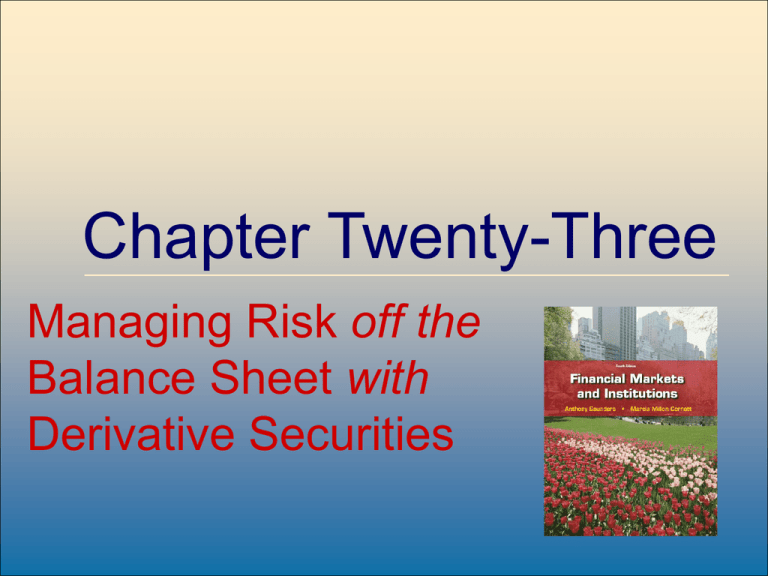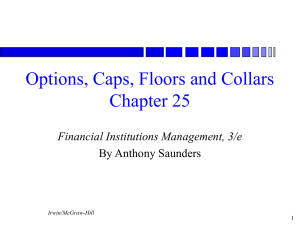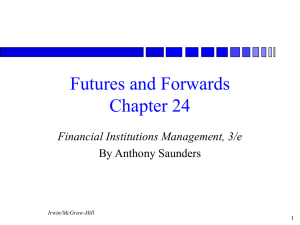
Chapter Twenty-Three
Managing Risk off the
Balance Sheet with
Derivative Securities
McGraw-Hill/Irwin
8-1
©2009, The McGraw-Hill Companies, All Rights Reserved
Managing Risk off the Balance Sheet
• Managers are increasingly turning to off-balancesheet (OBS) instruments such as forwards,
futures, options, and swaps to hedge the risks
their financial institutions (FIs) face
– interest rate risk
– foreign exchange risk
– credit risk
• FIs also generate fee income from derivative
securities transactions
McGraw-Hill/Irwin
23-2
©2009, The McGraw-Hill Companies, All Rights Reserved
Managing Risk off the Balance Sheet
• A spot contract is an agreement to transact involving the
immediate exchange of assets and funds
• A forward contract is an agreement to transact involving
the future exchange of a set amount of assets at a set price
• A futures contract is an agreement to transact involving
the future exchange of a set amount of assets for a price
that is settled daily
– futures contracts are marked to market daily—i.e., the prices on
outstanding futures contracts are adjusted each day to reflect
current futures market conditions
McGraw-Hill/Irwin
23-3
©2009, The McGraw-Hill Companies, All Rights Reserved
Hedging with Forwards
• A naïve hedge is a hedge of a cash asset on a direct
dollar-for-dollar basis with a forward (or futures) contract
• Managers can predict capital loss (ΔP) using the duration
formula:
R
P D P
(1 R)
where
P = the initial value of an asset
D = the duration of the asset
R = the interest rate (and thus ΔR is the change in interest)
• FIs can immunize assets against risk by using hedging to
fully protect against adverse movements in interest rates
McGraw-Hill/Irwin
23-4
©2009, The McGraw-Hill Companies, All Rights Reserved
Hedging with Futures
• Microhedging is using futures (or forwards)
contracts to hedge a specific asset or liability
– basis risk is a residual risk that occurs because the
movement in a spot asset’s price is not perfectly
correlated with the movement in the price of the asset
delivered under a futures (or forwards) contract
– firms use short positions in futures contracts to hedge
an asset that declines in value as interest rates rise
• Macrohedging is hedging the entire (leverageadjusted) duration gap of an FI
McGraw-Hill/Irwin
23-5
©2009, The McGraw-Hill Companies, All Rights Reserved
Hedging with Futures
• Microhedging and macrohedging
– risk-return considerations
• FIs hedge based on expectations of future interest rate
movements
• FIs may microhedge, macrohedge, or even overhedge
– accounting rules can influence hedging strategies
• in 1997 FASB required that all gains and losses from
derivatives used to hedge must be recognized immediately
• U.S. companies must report derivative related trading activity
in annual reports
• futures contracts are not subject to risk-based capital
requirements impose by bank regulators (forward can be)
McGraw-Hill/Irwin
23-6
©2009, The McGraw-Hill Companies, All Rights Reserved
Options
• Many types of options are used by FIs to hedge
–
–
–
–
exchange-traded options
over-the-counter (OTC) options
options embedded in securities
caps, collars, and floors
• Buying a put option on a bond can hedge interest rate risk
exposure related to bonds that are held as assets
– the put option truncates the downside losses
– the put option scales down the upside profits, but still leaves
upside profit potential
• Similarly, buying a call option on a bond can hedge
interest rate risk exposure related to bonds held on the
liability side of the balance sheet
McGraw-Hill/Irwin
23-7
©2009, The McGraw-Hill Companies, All Rights Reserved
Hedging with Put Options
Payoff
Gain
Payoff for a bond
held as an asset
Net payoff function
0
Bond price
X
-P
Payoff from
buying a put
on a bond
Payoff
Loss
McGraw-Hill/Irwin
23-8
©2009, The McGraw-Hill Companies, All Rights Reserved
Options
• Buying a call option on a bond
– as interest rates fall, bond prices rise, and the call
option buyer has a large profit potential
– as interest rates rise, bond prices fall, but the call
option losses are bounded by the call option premium
• Writing a call option on a bond
– as interest rates fall, bond prices rise, and the call
option writer has a large potential losses
– as interest rates rise, bond prices fall, but the call
option gains are bounded by the call option premium
McGraw-Hill/Irwin
23-9
©2009, The McGraw-Hill Companies, All Rights Reserved
Options
• Buying a put option on a bond
– as interest rates rise, bond prices fall, and the put
option buyer has a large profit potential
– as interest rates fall, bond prices rise, but the put option
losses are bounded by the put option premium
• Writing a put option on a bond
– as interest rates rise, bond prices fall, and the put
option writer has large potential losses
– as interest rates fall, bond prices rise, but the put option
gains are bounded by the put option premium
McGraw-Hill/Irwin
23-10
©2009, The McGraw-Hill Companies, All Rights Reserved
Caps, Floors, and Collars
• Buying a cap means buying a call option, or a succession
of call options, on interest rates
– like buying insurance against an (excessive) increase in interest
rates
• Buying a floor is akin to buying a put option on interest
rates
– seller compensates the buyer should interest rates fall below the
floor rate
– like caps, floors can have one or a succession of exercise dates
• A collar amounts to a simultaneous position in a cap and a
floor
– usually involves buying a cap and selling a floor
McGraw-Hill/Irwin
23-11
©2009, The McGraw-Hill Companies, All Rights Reserved
Contingent Credit Risk
• Contingent credit risk is the risk that the
counterparty defaults on payment obligations
– forward contracts are exposed to counterparty default
risk as they are nonstandard contracts entered into
bilaterally
– options traded OTC are exposed to counterparty risk
– futures and options traded on organized exchanges are
exposed to relatively less contingent credit risk
• the exchanges act as guarantors in the transactions
• the contracts are marked-to-market daily so losses (and gains)
are realized daily
McGraw-Hill/Irwin
23-12
©2009, The McGraw-Hill Companies, All Rights Reserved
Swaps
• Swap agreements involve restructuring asset or liability
cash flows in a preferred direction
• The market for swaps has grown enormously in recent
years
– the notional value of swap contracts outstanding at U.S.
commercial banks was more than $111 trillion in 2008
• There are several types of swaps
–
–
–
–
–
interest rate swaps
currency swaps
credit risk swaps
commodity swaps
equity swaps
McGraw-Hill/Irwin
23-13
©2009, The McGraw-Hill Companies, All Rights Reserved
Swaps
• Hedging with interest rate swaps: an example
– a money center bank (MCB) may have floating-rate
loans and fixed-rate liabilities
• the MCB has a negative duration gap
– a savings bank (SB) may have fixed-rate mortgages
funded by short-term liabilities such as retail deposits
• the SB has a positive duration gap
– accordingly, an interest swap can be entered into
between the MCB and the SB either:
• directly between the two FIs
• indirectly through a broker or agent who charges a fee to
accept the credit risk exposure and guarantee the cash flows
McGraw-Hill/Irwin
23-14
©2009, The McGraw-Hill Companies, All Rights Reserved
Swaps
• (example cont.)
– a plain vanilla swap is used—i.e., a standard
agreement without any special features
– the SB sends fixed-rate interest payments to the MCB
• thus, the MCB’s fixed-rate inflows are now matched to its
fixed-rate payments
– the MCB sends variable-rate interest payments to the
SB
• thus, the SB’s variable-rate inflows are now matched to its
variable-rate payments
McGraw-Hill/Irwin
23-15
©2009, The McGraw-Hill Companies, All Rights Reserved
Swaps
McGraw-Hill/Irwin
23-16
©2009, The McGraw-Hill Companies, All Rights Reserved
Swaps
• Hedging with currency swaps: an example
– consider a U.S. FI with fixed-rate $ denominated assets
and fixed-rate £ denominated liabilities
– also consider a U.K. FI with fixed-rate £ denominated
assets and fixed-rate $ denominated liabilities
– the FIs can engage in a currency swap to hedge their
foreign exchange exposure
• that is, the FIs agree on a fixed exchange rate at the inception
of the swap agreement for the exchange of cash flows at some
point in the future
• both FIs have effectively hedged their foreign exchange
exposure by matching the denominations of their cash flows
McGraw-Hill/Irwin
23-17
©2009, The McGraw-Hill Companies, All Rights Reserved
Credit Risk and Swaps
• The growth of the over-the-counter swap market was a
major factor underlying the imposition of the BIS riskbased capital requirements
– the fear was that out-of-the-money counterparties would have
incentives to default
– BIS now requires capital to be held against interest rate, currency,
and other swaps
• Credit risk on swaps differs from that on loans
– netting: only the difference between the fixed and the floating
payment is exchanged between swap parties
– payment flows are interest and not principal
– standby letters of credit are required of poor-quality swap
participants
McGraw-Hill/Irwin
23-18
©2009, The McGraw-Hill Companies, All Rights Reserved
Comparing Hedging Methods
• Writing vs. buying options
– writing options limits upside profits but not downside losses
– buying options limits downside losses but not upside profits
– CBs are prohibited from writing options in some areas
• Futures vs. options hedging
– futures produces symmetric gains and losses
– options protect against losses but do not fully reduce gains
• Swaps vs. forwards, futures, and options
– swaps and forwards are OTC contracts, unlike options and futures
– futures are marked to market daily
– swaps can be written for longer time horizons
McGraw-Hill/Irwin
23-19
©2009, The McGraw-Hill Companies, All Rights Reserved
Regulation
• Regulators specify “permissible activities” that FIs may
engage in
• Institutions engaging in permissible activities are subject
to regulatory oversight
• Regulators judge the overall integrity of FIs engaging in
derivatives activity based on capital adequacy regulation
• The Securities and Exchange Commission (SEC) and
the Commodity Futures Trading Commission (CFTC)
are the functional regulators of derivatives securities
markets
McGraw-Hill/Irwin
23-20
©2009, The McGraw-Hill Companies, All Rights Reserved
Regulation
• The Federal Reserve, the Federal Deposit Insurance Corporation
(FDIC) and the Office of the Comptroller of the Currency (OCC)
have implemented uniform guidelines that require banks to:
– establish internal guidelines regarding hedging activity
– establish trading limits
– disclose large contract positions that materially affect the risk to
shareholders and outside investors
• As of 2000 the FASB requires all firms to reflect the marked-tomarket value of their derivatives positions in their financial statements
• Swap markets are governed by relatively little regulation—except
indirectly at FIs through bank regulatory agencies
McGraw-Hill/Irwin
23-21
©2009, The McGraw-Hill Companies, All Rights Reserved









